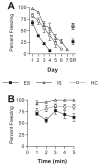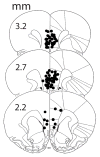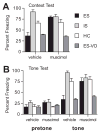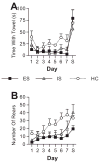Controllable versus uncontrollable stressors bi-directionally modulate conditioned but not innate fear
- PMID: 17478046
- PMCID: PMC1978104
- DOI: 10.1016/j.neuroscience.2007.03.042
Controllable versus uncontrollable stressors bi-directionally modulate conditioned but not innate fear
Abstract
Fear conditioning and fear extinction play key roles in the development and treatment of anxiety-related disorders, yet there is little information concerning experiential variables that modulate these processes. Here we examined the impact of exposure to a stressor in a different environment on subsequent fear conditioning and extinction, and whether the degree of behavioral control that the subject has over the stressor is of importance. Rats received a session of either escapable (controllable) tail shock (ES), yoked inescapable (uncontrollable) tail shock (IS), or control treatment (home cage, HC) 7 days before fear conditioning in which a tone and foot shock were paired. Conditioning was measured 24 h later. In a second experiment rats received ES, IS or HC 24 h after contextual fear conditioning. Extinction then occurred every day beginning 7 days later until a criterion was reached. Spontaneous recovery of fear was assessed 14 days after extinction. IS potentiated fear conditioning when given before fear conditioning, and potentiated fear responding during extinction when given after conditioning. Importantly, ES potently interfered with later fear conditioning, decreased fear responding during fear extinction, and prevented spontaneous recovery of fear. Additionally, we examined if the activation of the ventral medial prefrontal cortex (mPFCv) by ES is critical for the protective effects of ES on later fear conditioning. Inactivation of the mPFCv with muscimol at the time of the initial experience with control prevented ES-induced reductions in later contextual and auditory fear conditioning. Finally, we explored if the protective effects of ES extended to an unconditioned fear stimulus, ferret odor. Unlike conditioned fear, prior ES increased the fear response to ferret odor to the same degree as did IS.
Figures





References
-
- Amat J, Baratta MV, Paul E, Bland ST, Watkins LR, Maier SF. Medial prefrontal cortex determines how stressor controllability affects behavior and dorsal raphe nucleus. Nat Neurosci. 2005;8:365–371. - PubMed
-
- Bouton ME. Context and behavioral processes in extinction. Learn Mem. 2004;11:485–494. - PubMed
Publication types
MeSH terms
Substances
Grants and funding
LinkOut - more resources
Full Text Sources

